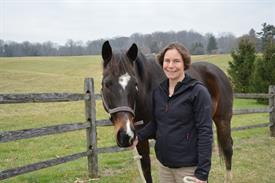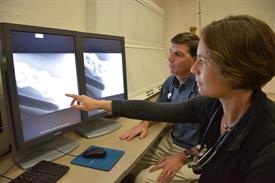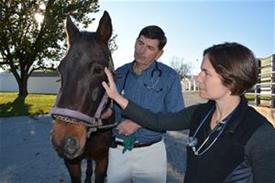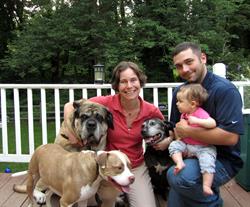It started with baby birds, the ones that sometimes fell out of the nest. A very young Dr. Amy Johnson hand-fed them, taking care until they could go out on their own.
By the time she was nine years old, she had decided to be a veterinarian. “I always loved animals,” said Johnson, now Assistant Professor of Large Animal Internal Medicine and Neurology at Penn Vet’s New Bolton Center. “I also always wanted to ride horses. It took me a very long time to convince my parents that riding was something I needed to do.”
 Convince them, she did. Johnson started with riding lessons, and just as she became a teenager, she bought Angel, a spirited buckskin, paying $500 of her own cash.
Convince them, she did. Johnson started with riding lessons, and just as she became a teenager, she bought Angel, a spirited buckskin, paying $500 of her own cash.
That kind of focused determination has been an enduring and essential characteristic as Johnson aimed toward and graduated from the University of Pennsylvania, followed by Cornell University’s College of Veterinary Medicine.
And she kept going. A one-year internship at a private equine practice was followed by three more years at Cornell’s vet school to complete residency and board certification in large animal internal medicine. Then on to a full-time job as a Lecturer in Medicine at Penn Vet—where the faculty created a customized four-year program for her to achieve board certification in neurology.
While juggling the responsibilities of the lecturer position, Johnson became the first American veterinarian—and only the second veterinarian in the world, following Dr. I.G. Joe Mayhew of New Zealand—to be granted dual certification in neurology and large animal internal medicine through the American College of Veterinary Internal Medicine (ACVIM).
“There are large animal internists interested in neurology. But in terms of getting specialized training and board certification in neurology, she is definitely a real pioneer,” said Dr. Raymond Sweeney, Chief of New Bolton Center’s Section of Medicine and Ophthalmology.
Johnson’s interest in neurology started at Cornell, inspired by specialists on the faculty. “Amy has developed a reputation as one of the top equine neurologists in the country,” said Dr. Thomas Divers, Cornell’s Chief of Large Animal Internal Medicine. “Penn is extremely fortunate to have her.”
Sweeney agrees. “Amy is undoubtedly one of the smartest people I know, “ he said. “But even more significantly, she is also one of the nicest.”
Bound for Penn
Growing up in Pitman, New Jersey, Johnson was surrounded by a menagerie of animals. She learned to walk by hanging onto the family dog. But horses became Johnson’s passion, and she spent every spare moment at the barn.
She was 12 years old when she took her first riding lesson. “I was hooked immediately,” she said. “We cleaned stalls, tacked up the horses, and led the ponies, in exchange for lessons.”
During all those days and nights at the barn, she watched the veterinarians care for the horses. “They were young and female and cool,” Johnson recalled, noting that she learned how to give daily medicine treatments. “I got to be really involved in the care. I was helping, and it was so interesting.”
 Top of her 1995 Pitman High School class, and a competitive varsity field hockey player, Johnson was determined to go to Penn. She was inspired by her grandfather, Dr. Herbert Johnson, a graduate of Penn’s medical school who practiced in Camden.
Top of her 1995 Pitman High School class, and a competitive varsity field hockey player, Johnson was determined to go to Penn. She was inspired by her grandfather, Dr. Herbert Johnson, a graduate of Penn’s medical school who practiced in Camden.
As a biology major, Johnson landed a work-study job with Penn Medicine’s Dr. Michael Beers, assisting with his pulmonary research. Always focused on the future, Johnson applied to and was accepted early admission to Cornell’s veterinary school when she was just a sophomore.
Vet School and Beyond
At Cornell, Johnson set her sights on large animal internal medicine, and eventually focused on a specialty in neurology. Dr. Alexander de Lahunta, considered the grandfather of veterinary neurology, profoundly influenced her. “We learned all of the neuroanatomy in our first year, looking at slices of brain, the connecting pathways,” she said. “We examined cases when [the animals] were alive, and post-mortem, which is unusual.”
She enriched her studies during her internship at B.W. Furlong and Associates, a private equine practice in New Jersey, where Penn Vet alumnae Dr. Wendy Vaala, V’80, Dr. Margaret Mullin, V’96, and Dr. Stacey Kent, V’99, were her mentors.
Divers was another mentor who worked with Johnson when she was a vet student, and also during her three-year residency at Cornell. “She is extremely bright and has exceptional clinical skills,” he said.
“She was inquisitive, always looking for new ideas that might improve our understanding of a disease process and the patient care of animals,” Divers continued. “She also has a terrific presentation style that allows her to effectively disseminate her findings and knowledge to others. She taught me much more than I ever taught her!”
Choosing a Career Path
As Johnson was nearing the end of her residency, she started to look for her first job. “This was the only part of my life when I didn’t know what I was going to do next,” she recalled.
Pursue a PhD, go into a private practice, or head to Europe to ride ponies? She decided to pursue a job at a university teaching hospital.
“I really wanted referral cases that were medical mysteries, to have to figure out the answer,” she said. University hospitals offered that opportunity, as well as teaching and research.
Divers knew Sweeney, another one of his outstanding residents, and made the Penn Vet connection. “She was on our radar screen as an up-and-coming star in the profession. We recruited her,” Sweeney said.
Working with Sweeney and Dr. Jill Beech at New Bolton Center—as well as Dr. Charles Vite, Associate Professor of Veterinary Neurology, and Dr. Sheldon Steinberg, Professor Emeritus of Neurology, at Ryan Hospital—Johnson tackled the nontraditional program to earn the neurology certification. It required that she learn small animal neurology, as well as large animal, and go back and forth between Penn Vet’s two campuses. It took four years, from 2007 to 2011.
Johnson admits that it was grueling. “I was in a training program until I was 34,” she said. “I like to say that I went through 28th grade.”
“There is a long history of clinicians at Penn Vet very interested in working on neurological disease,” she added, noting that the National Botulism Reference Laboratory at New Bolton Center, founded by Dr. Robert Whitlock, has been an invaluable resource for her research.
Leading in Large Animal Neurology
 In July 2011, Johnson joined the New Bolton Center faculty as Assistant Professor of Large Animal Internal Medicine and Neurology. In addition to horses, she treats all large animals, and is especially sought-after for cows and goats.
In July 2011, Johnson joined the New Bolton Center faculty as Assistant Professor of Large Animal Internal Medicine and Neurology. In addition to horses, she treats all large animals, and is especially sought-after for cows and goats.
The cases she sees most often are neurologic infectious diseases such as equine protozoal myeloencephalitis (EPM), as well as cervical vertebral (neck) problems. Her research focuses on EPM, botulism, and neurologic Lyme disease. One main goal in her work is to improve the diagnosis while the animal is still alive. Traditionally, neurologic diseases are determined in autopsies.
Johnson’s published research has already been put into practice. For example, her research on EPM has identified tests that can improve treatment—not only the best combinations of tests, but the interpretation as well.
“She’s very productive as a researcher, even though the majority of her time is spent in clinics and teaching,” Sweeney said.
Johnson is a key member of the team working on cases throughout the hospital, from sports medicine to surgery.
Dr. Elizabeth Davidson, Associate Professor of Sports Medicine, says Johnson is “excellent” to work with. “She has an insatiable appetite to know, like most of us here. We want to know. We want to investigate,” said Davidson, who often works with Johnson on lameness cases.
“Amy is spectacularly collegial,” added Dr. Rose Nolen-Walston, Assistant Professor of Large Animal Internal Medicine. “Even when she is busy with her own work, she is always willing to look at a neurologic case and give us her opinion on it.”
The goal is to give the client as much information as possible about their animal to determine the best course of treatment. “Neurologic problems are emotionally devastating to clients,” Sweeney said. “Amy is very good at explaining things to clients, and offering them a wide range of options, from most heroic to most practical, and tailoring the treatment to the clients’ needs and wishes.”
Interns, residents, and students also seek out her “stall side” instruction and classroom lectures. “She is so unbelievably knowledgeable without being intimidating,” said Dr. Michelle Linton, a Large Animal Internal Medicine Fellow who recently completed her three-year residency at New Bolton Center. “She has a remarkable ability to supervise without being controlling. You are comfortable because you know she is there and will back you up, but you have the freedom to explore the case.”
Balancing Act
An adept multitasker, Johnson, now 38, balances her thriving career with her family life.
 She met her husband, Mike Alessi, while an undergraduate at Penn; he was a friend of a friend, visiting from the University of Maryland. They dated long-distance for the next 10 years, settling in Rose Valley, Pennsylvania, and then marrying in 2010. Alessi is a chemical engineer.
She met her husband, Mike Alessi, while an undergraduate at Penn; he was a friend of a friend, visiting from the University of Maryland. They dated long-distance for the next 10 years, settling in Rose Valley, Pennsylvania, and then marrying in 2010. Alessi is a chemical engineer.
Two years ago, Johnson had their first child, a daughter. And she is pregnant with their second, a son, due this spring. She is grateful for the “very supportive” atmosphere at New Bolton Center for parents of young children.
Another member of the family is October Surprise, “Toby,” an off-the-track Thoroughbred gelding Johnson bought in 2008 when he was three years old. A handsome, dark bay horse, she first rode him over miles of open countryside during a paperchase at Fair Hill, a ride set up by colleague and friend Nolen-Walston.
Characteristically, she was determined to accomplish the challenge. “I had never ridden a racehorse, never re-trained a Thoroughbred,” Johnson said. “He’d never been mounted from the ground before, but I got on him anyway and headed off.”